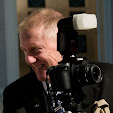I was photographing Boy Scouts of America, Utah National Parks Council, Silver Beaver recipients last night in American Fork, Utah. I have 93 of them in the council to photograph this year and so I go to key locations and have them come to me. Well that requires a little waiting while they arrive at different times according to their abilities and schedules. So last night I arrived a little early and set up the flag that I would use as the backdrop and since this is a scouting thing I did it outdoors. ("Scouting" is "Outing" when you take off the "S".) Anyway so while waiting for the first one I took a couple shots of the mountains that I could see from there. (MT Timpanogos and the peak behind Alpine, Utah) Then during the course of the next three hours as I would wait I read in a book "The Creative Digital Darkroom" by "Katrin Eismann" and "Sean Duggan". The subject matter was on the use of the blending filters in Photoshop and making black and white images with some of them. So for my few minutes of personal study this morning to make my knowledge of Photoshop better I practiced a couple of the uses of the filters and also the use of other thing in photoshop that I have been learning in the past.
The following are what I came up with and as usual I leave it to you to be the judge of what you like the best.

This first image seen above was saved as it was taken in the camera Raw original image.

This second one was with a standard levels adjustment.

Here in the third one I used the Multiply blend mode with the second layer opacity moved back to Approx. 70 %.

In the fourth one I applied the LAB process with the multiply blend mode and opacity dropped again on that layer to 70%.

The final image of this series was made using the Black and White Adjustment layer option to increase the contrast of the image by adjusting each specific color level.

These last two images were made by using the Multiply blend mode and the Black and White adjustment layers as in the first series.

 This first image seen above was saved as it was taken in the camera Raw original image.
This first image seen above was saved as it was taken in the camera Raw original image. This second one was with a standard levels adjustment.
This second one was with a standard levels adjustment. Here in the third one I used the Multiply blend mode with the second layer opacity moved back to Approx. 70 %.
Here in the third one I used the Multiply blend mode with the second layer opacity moved back to Approx. 70 %.






No comments:
Post a Comment